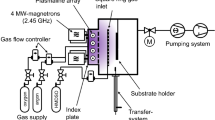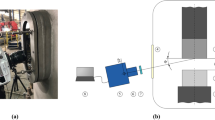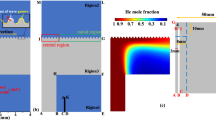Abstract
This research article delves into an in-depth analysis of atmospheric pressure plasma and its temperature distribution, utilizing the finite element method (FEM) and Ansys Mechanical software. This contribution discusses the various technological applications of atmospheric pressure plasma, including surface treatment, material processing, and plasma equipment, where precise plasma and temperature behavior prediction is crucial for an optimization and innovative solutions. The simulations presented provide a detailed representation of plasma and temperature behavior, and the simulation models have been validated against experimental data, demonstrating the accuracy and reliability of the approaches used. The deviation between the simulation and the actual measurement results was a maximum of 0.87%. In addition, the implications of the findings of this research for optimizing plasma applications and future research directions are discussed. This study highlights the crucial role of simulation tools, such as Ansys Mechanical, for investigating and optimizing atmospheric pressure plasma applications.
Zusammenfassung
In diesem Forschungsartikel wird eine gründliche Untersuchung des Atmosphärendruckplasmas und seiner Temperaturverteilung vorgestellt, wobei die Finite-Elemente-Methode (FEM) in Kombination mit der Software Ansys Mechanical eingesetzt werden. Dieser Beitrag gibt einen detaillierten Einblick in die technologischen Anwendungen von Atmosphärendruckplasma, die ein breites Spektrum von Bereichen wie Oberflächenbehandlung, Materialverarbeitung und Plasmaanlagen abdecken. Die genaue Vorhersage des Plasma- und Temperaturverhaltens ist in diesen Bereichen von größter Bedeutung, da sie die Optimierung von Prozessen und die Entwicklung innovativer Lösungen ermöglicht. Durch die Konkretisierung der Feinheiten des Atmosphärendruckplasmas soll diese Forschungsarbeit zum Fortschritt in diesen Bereichen beitragen und weitere Forschung anregen. Die in diesem Artikel vorgestellten Simulationen bieten eine detaillierte Darstellung des Plasma- und Temperaturverhaltens, und die Simulationsmodelle wurden anhand experimenteller Daten validiert, was die Genauigkeit und Zuverlässigkeit der verwendeten Ansätze belegt. Die Abweichung zwischen der Simulation und den realen Messergebnissen betrug maximal 0,87 %. Darüber hinaus werden die Auswirkungen der Ergebnisse dieser Forschung auf die Optimierung von Plasmaanwendungen und künftige Forschungsrichtungen erörtert. Diese Studie unterstreicht die entscheidende Rolle von Simulationswerkzeugen wie Ansys Mechanical für die Untersuchung und Optimierung von Atmosphärendruck-Plasmaanwendungen.
Similar content being viewed by others
Avoid common mistakes on your manuscript.
1 Introduction
Integrating Finite Element (FE) simulations with actual temperature measurements using Ansys Mechanical software is a sophisticated technique that enhances the accuracy of simulation outcomes and validates the model validation process [1].
FE simulations are computer-generated mathematical models that predict the performance of complex engineering systems under various circumstances. Ansys Mechanical is a robust software tool that empowers engineers to simulate various physical phenomena and structures [2].
However, the precision of even the most advanced simulation models relies on the input data that generates them. This is the state where actual temperature measurements become critical. By gathering information on the actual temperature of a system or structure during its operation, engineers can compare it with the simulated outcomes and make necessary adjustments to the model [3].
This approach is precious for complex systems with multiple variables that can affect the results. By merging real-world data with computer simulations, engineers can understand how a system will perform under different conditions and make informed decisions about improving its design [4].
2 Experimental
2.1 Carrying out the Temperature Measurements
When evaluating a system, it is necessary first to determine its essential components, interfaces, and locations where temperature measurements are needed. This process involves considering factors like how temperature changes may affect the system’s performance and the importance of its components and interfaces. Once measuring points have been identified, temperature readings can be taken and analyzed to gain insights into the system’s behavior and performance. This information can optimize the system’s performance, detect potential issues, and improve its reliability and safety.
To measure temperatures in specific areas, appropriate sensors must be chosen. Depending on the application’s requirements, sensors like thermocouples, thermistors, infrared cameras, or other temperature sensors may be used. We selected four thermocouples for our experiments and placed them on a 50 × 50 × 3 mm aluminum sample, as illustrated in Fig. 1. These thermocouples were positioned at the most critical points: the center bottom and top sides of the substrate (T1 and T2), the last point of contact between the plasma and substrate (T3), and the first point of contact between the plasma and substrate (T4) (Fig. 2).
The aluminum platform and the sample were traversed in a meander-shaped grid with a traverse length of 100 mm and a path offset of 5 mm. Table 1 shows the currents and travel speeds used.
INO GmbH in Attnang-Puchheim, Austria, utilized the InoCoat3 Plasma Jet as the plasma source (Fig. 3).
2.2 Integration of the Measurement Data into the Simulation
Simulating power flux density involves converting temperature results while accounting for critical parameters such as the current and voltage of the plasma source, the distance between the plasma source and substrate, and the efficiency of the plasma system.
In Finite Element (FE) modeling for simulating real-world events, it is essential to incorporate measurement data into the models to achieve accurate results. This process may entail modifications such as additional measurement points, defining boundary conditions based on measured temperatures, or other adjustments to ensure the simulation aligns with the actual physical conditions (Table 2).
The structural analysis begins with a 3D model of the structure or an imported one into Ansys Mechanical. The model includes components that interact with each other. The thermal properties of a material include thermal conductivity, specific heat, and density, which are essential for calculating heat transfer. The thickness of the material also plays an important role. Therefore, the dimensions of the materials used and simulated must match exactly otherwise the measurement results cannot be compared. During mesh generation, the model is divided into meshes (element size of 1 mm), and boundary conditions determine the system’s behavior in different circumstances. Ansys Mechanical uses the finite element method to solve heat transfer equations accurately. After the simulation, results are analyzed to extract meaningful information. Validation and iteration verify the accuracy of results, refine the model, and optimize the design [2, 5].
3 Results and Discussion
3.1 Comparison of Simulation and Measurements
During the validation and iteration stage of a simulation, it is essential to verify the accuracy of the results. This verification is done by comparing the results with the available experimental data to ensure that the simulation can be relied upon for informed decision-making. A thorough examination of the simulation results and comparison with experimental data helps to identify any discrepancies or gaps in the model. If any issues are found, the simulation model can be refined and improved through iterations. This process is invaluable for optimizing the design and addressing any problems that may have arisen during the simulation. Continuous validation and iteration can enhance the accuracy of the results, making the simulation a reliable tool for decision-making.
Analyzing a match efficiently requires a careful comparison of simulated and measured temperatures. Visual aids like diagrams, comparison plots, or thermal images can be helpful in this process, as well as quantitative assessments that identify potential causes and account for any deviations. However, it is essential to approach these comparisons cautiously to ensure accuracy in identifying and resolving discrepancies. When comparing temperatures, it is crucial to consider all relevant variables, such as humidity, gas flows, and intensity. Additionally, quantitative comparisons are necessary for detecting deviations and potential causes. Considering these factors, a thorough and reliable analysis can be obtained.
The deviations between the measured and simulated temperatures are analyzed to determine their underlying causes. This analysis involves determining whether the errors are due to model inaccuracies, measurement errors, or other factors influencing them. Improving accuracy may require iterating the model or measurement configuration. The results of this analysis are shown in Fig. 4.
Once the simulation process is complete, it is essential to carefully analyze the results to extract meaningful information (Fig. 5). This process may include parameters such as the maximum temperature, distribution of temperature changes over time, heat flow patterns, and other relevant data. The images in Fig. 5 were taken from the video created by the software.
3.2 Validation and Optimization
In engineering, finite element (FE) models are widely used for critical analyses, such as predicting the thermal performance of various designs. To ensure that such models are reliable and accurate, conducting a comprehensive validation process that compares simulation results with actual measurement results is essential. This validation process also helps identify discrepancies between the two sets of results and, if necessary, refine the model’s boundary conditions to improve its validity.
Once the FE model has been validated, it can simulate various scenarios that help identify optimal design changes for enhancing thermal performance. By subjecting the model to different simulations, engineers can predict the effects of potential design changes, which makes it easier to determine the most viable options. This process is particularly useful in optimizing designs for energy-efficient buildings.
By validating simulated results, a high degree of accuracy can be achieved in matching measured temperatures. This precision allows for a quick determination of plasma parameters and an optimization of the testing procedure. With a minimal deviation from actual measurements, the focus can be shifted towards more intricate simulations, offering a deeper comprehension of the processes at hand [2].
Figure 6 compares measured and simulated results, displaying current levels of other experiments conducted at the same travel speed. The results indicate that the temperature reaches its highest point when the amperage is high and the travel speed is low. Conversely, a substantial reduction in temperature is observed when the amperage is lowered, and the travel speed is increased, as expected. These trends are valuable for predicting outcomes at both lower and higher currents.
In order to accurately identify any discrepancies, we conducted a thorough analysis of the temperature readings obtained from both recording and simulation methods. We aimed to compare the results obtained under similar conditions but at different speeds. To this end, we used various tools and techniques to measure the temperature at various points and locations. Our findings, as illustrated in Fig. 7, indicate that a higher travel speed is associated with a significant reduction in temperature. This information can help us better understand the impact of speed on temperature and guide future research on this topic.
As previously discussed, Ansys Mechanical simulation heavily relies on the power flux parameter, encompassing a range of factors, including current, voltage, plasma-substrate distance, plasma efficiency, and plasma area. Throughout the simulation study, we have identified some significant trends in the power flux, illustrated in Fig. 8. For instance, the power flux value increases with higher travel speeds. However, it is worth noting that the software assumes an optimal and uniform movement, which does not necessarily reflect real-world complexities like friction, air resistance, and environmental heating. Therefore, it is crucial to adjust the power flux accordingly. The power flux value reaches its maximum at higher speeds but decreases at lower currents. At lower currents, the impact of temperature on the environment is significantly less than at higher currents, which can help make more precise predictions about plasma pre-treatments and coatings.
4 Conclusion
Incorporating precise actual temperature measurements into finite element (FE) simulations is vital for understanding a system’s thermal behavior and ensuring accurate predictive models. With FE simulations, we can replicate complex physical phenomena and anticipate a system’s behavior under different conditions. By integrating actual temperature measurements, we can enhance the accuracy of FE simulations, identifying potential design flaws and optimizing product performance. This technique is especially crucial in industries where effective thermal management is essential, such as aerospace, automotive, and electronics. Accurate thermal simulations can help reduce development costs, shorten time-to-market, and improve product reliability. Thus, integrating actual temperature measurements in FE simulations is essential in develo** and optimizing products and processes.
References
Brieda, L.: Plasma simulations by example. CRC Press Taylor & Francis Group, Boca Raton, USA (2021)
Altabey, W.: Using ansys for finite element analysis: A tutorial for engineers. Momentum Press, New York (2018)
Colonna, G., D’Angola, A. (eds.): Plasma modeling: Methods and applications, 20221101st edn. IOP series in plasma physics. IOP Publishing, Bristol, UK (2022)
Kawata, S.: Computational Plasma Science: Physics and Selected Simulation Examples, 1st edn. Springer, Singapore (2023)
Pawłowski, L.: The science and engineering of thermal spray coatings, 2nd edn. Wiley, Chichester, England (etc.) (2008)
Acknowledgements
The authors thank Carina Hendler and Jürgen M. Lackner for proofreading this contribution. The European Commission is acknowledged for funding the “MIMOSA” project (no. 101091826) under the Horizon 2020 European Union funding for Research & Innovation program.
Funding
Open access funding provided by JOANNEUM RESEARCH Forschungsgesellschaft mbH
Author information
Authors and Affiliations
Corresponding author
Additional information
Publisher’s Note
Springer Nature remains neutral with regard to jurisdictional claims in published maps and institutional affiliations.
Rights and permissions
Open Access This article is licensed under a Creative Commons Attribution 4.0 International License, which permits use, sharing, adaptation, distribution and reproduction in any medium or format, as long as you give appropriate credit to the original author(s) and the source, provide a link to the Creative Commons licence, and indicate if changes were made. The images or other third party material in this article are included in the article’s Creative Commons licence, unless indicated otherwise in a credit line to the material. If material is not included in the article’s Creative Commons licence and your intended use is not permitted by statutory regulation or exceeds the permitted use, you will need to obtain permission directly from the copyright holder. To view a copy of this licence, visit http://creativecommons.org/licenses/by/4.0/.
About this article
Cite this article
Chwatal, S., Parizek, H. & Waldhauser, W. Simulation-based Analysis of the Atmospheric Pressure Plasma and Its Temperature Distribution Using Ansys Mechanical. Berg Huettenmaenn Monatsh (2024). https://doi.org/10.1007/s00501-024-01477-1
Received:
Accepted:
Published:
DOI: https://doi.org/10.1007/s00501-024-01477-1












